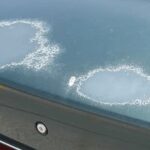A flawless car exterior speaks volumes about your vehicle’s upkeep and your attention to detail. However, the realities of daily driving often lead to dents and dings, especially on vulnerable areas like car doors. These imperfections not only detract from your car’s appearance but can also diminish its resale value and potentially lead to rust formation on metal surfaces. Understanding how to repair dents car door metal is a valuable skill for any car owner looking to maintain their vehicle’s condition.
While significant damage might necessitate professional intervention, many common metal car door dents can be effectively repaired at home using DIY methods. From minor dings to noticeable indentations, there are techniques and tools available to help you restore your car door’s smooth finish. This guide will walk you through the essential steps and options for tackling metal car door dents yourself, saving you time and money while enhancing your car’s overall look.
Various incidents can cause dents in your car door’s metal panels, even with careful driving habits.
Small dents might arise from hail, road debris kicked up while driving, or even runaway shopping carts in parking lots. These seemingly minor events can leave noticeable marks on your car door’s metal.
Door dings are almost inevitable, occurring when your door bumps into another vehicle, a post, or a wall, or when someone else’s car door makes contact with yours. These are particularly common in tight parking spaces.
Larger, more prominent car door dents often result from more significant impacts, such as minor collisions, falling tree branches, or other considerable forces.
It’s helpful to understand the terminology used to describe different types of damage to your vehicle’s body panels. While “dent” and “ding” are often used interchangeably for minor damage, it’s useful to differentiate between various dent types to better understand the repair approach.
Beyond size and shape, the location of the dent is crucial. Car door panels are constructed from metal, typically steel or aluminum. Dents on these metal panels require different repair strategies compared to those on plastic bumpers.
Considering these factors, let’s look at common types of dents you might encounter on your car door:
| Type | Description | DIY Repair Suitability |
|---|---|---|
| Ding | A very small, shallow area of damage | Highly suitable for DIY |
| Round Dent | A circular indentation, often with a smooth edge | Often repairable with DIY methods |
| Sharp Dent | A small but deep, pointed indentation | More challenging for DIY, requires care |
| Crease Dent | A longer, linear dent, sometimes with paint damage | Can be attempted DIY for minor cases, professional recommended for paint damage |
| Serious Dent | Large or multiple dents, potentially with structural concerns | DIY not recommended, professional assessment needed |
Recognizing a dent on your car door should prompt timely action. Prompt repair isn’t just about aesthetics; it’s about maintaining your vehicle’s integrity. While DIY dent repair is budget-friendly, professional repairs can range significantly in cost.
Damage to the paint or metal of your car door can lead to moisture intrusion, causing rust and paint degradation. Larger dents, especially crease dents from impacts like tree branches, might conceal underlying structural damage, posing a safety risk. Even multiple dents can negatively impact your car’s aerodynamics, potentially lowering fuel economy. These are compelling reasons to address car door dents without delay. Fortunately, effective DIY options are available for many metal car door dent repairs.
For minor dents, door dings, or shallow damage on metal car doors, DIY repair can be a cost-effective and satisfying solution. Here’s a guide on how to repair dents car door metal at home:
DIY Methods for Metal Car Door Dent Repair
To effectively repair metal dents on your car door, you’ll benefit from using a specialized dent repair kit. These kits are readily available and typically include the necessary tools to gently pull the dented metal outwards, helping to restore the original shape of your car door.
Follow these steps for repairing metal car door dents:
-
Clean the Dent Area: Begin by thoroughly cleaning the area around the dent on your car door. Use soap and water to remove any dirt, grime, or wax. Dry the area completely with a microfiber towel to ensure a clean surface for repair.
-
Heat the Dent (Optional but Recommended): For most metal dents, applying gentle heat can make the metal more pliable and easier to work with. Use a hairdryer to warm the dented area. Heat it until the metal is warm to the touch, but not excessively hot. For very small, shallow dents, you might be able to skip this step.
-
Apply a Dent Puller: Dent pullers are essential tools in DIY dent repair kits. They utilize suction to gently pull the metal outwards. Position the suction cup of the dent puller directly over the center of the dent. Ensure a firm attachment and then gently start pulling outwards. The goal at this stage is to reduce the dent’s depth, not necessarily to eliminate it completely in one go.
-
Wipe and Assess: After using the dent puller, wipe the area again with a microfiber towel to remove any residue and to clearly see the progress. Evaluate the dent. If it’s a minor dent, you might see significant improvement at this stage. For deeper dents, proceed to the next steps.
-
Prepare the Bridge Puller: Many dent repair kits include a bridge puller. This tool provides more leverage for pulling out dents. It works with adhesive tabs (heads) that you attach to the dent. Begin by applying the specialized glue from your repair kit to a puller head.
-
Attach Bridge Puller Head: Press the glued puller head firmly onto the deepest point of the dent. Hold it in place for a few moments to ensure good adhesion. Allow the glue to dry completely, as per the kit’s instructions. This usually takes about 5-10 minutes, depending on the glue and ambient temperature.
-
Use the Bridge Puller: Once the glue is dry and the head is securely attached, position the bridge puller over the head, aligning the center screw with the head. Turn the dial or screw of the bridge puller slowly and steadily. This will apply controlled pressure to pull the dent outwards. Monitor the dent as you work. Stop when the dent is largely removed and the metal is close to its original contour. Avoid over-pulling, which can create new, unwanted protrusions.
-
Remove Head and Puller: After achieving the desired dent removal, detach the bridge puller. To remove the puller head, use the hairdryer again to gently heat the glue. This will soften the adhesive, making it easier to peel off the head from the car door. Wipe away any remaining glue residue with a clean microfiber towel and the adhesive remover if provided in the kit.
-
Touch Up Paint Damage: Inspect the repaired area for any paint damage, such as scratches or chips that might have been present before or caused during the denting incident. If there is paint damage, use a touch-up paint kit that matches your car’s color code. Clean the area, apply primer if necessary (depending on the touch-up kit), and then carefully apply thin layers of touch-up paint. Allow each layer to dry before applying the next.
Using Body Filler for Imperfect Metal Dent Repairs
In situations where DIY dent pulling methods don’t completely restore the car door’s surface to a perfectly smooth finish, body filler can be used to achieve a seamless repair. Body filler, like Bondo®, is a putty-like substance that fills in minor imperfections and can be sanded smooth to match the surrounding surface.
-
Prepare the Area: Ensure the repaired dent area is clean and dry. If you’ve already used dent pulling tools, make sure all residue is removed.
-
Sand the Area: Use 80-grit sandpaper to lightly sand the area around the dent, extending about 2-3 inches beyond the dented edges. This roughens the surface, providing better adhesion for the body filler. Remove any loose paint flakes but avoid sanding down to bare metal unless necessary.
-
Apply Body Filler: Following the product instructions, mix a small amount of body filler with its hardener. Apply the filler to the dent using a plastic spreader or applicator. Press firmly to ensure it fills the dent completely and slightly overfills it, standing slightly proud of the surrounding surface. Work quickly as body filler hardens relatively fast.
-
Allow to Dry and Sand: Let the body filler dry completely, usually for about 20-30 minutes, depending on the product and ambient conditions. Once hardened, use 80-grit sandpaper to begin shaping and leveling the filler. Sand down the high spots until the filler is flush with the surrounding car door panel.
-
Refine and Smooth: After shaping with 80-grit, switch to a finer 180-grit sandpaper to smooth out the surface and remove scratches left by the coarser grit. For an even smoother finish, you can follow up with 320-grit sandpaper.
-
Prime and Paint: Once you’re satisfied with the smoothness and shape of the filled area, clean it thoroughly to remove sanding dust. Apply automotive primer to the filled area and let it dry. Finally, apply your car’s matching touch-up paint in thin, even coats, allowing each coat to dry before applying the next, until you achieve good coverage and color match.
When Professional Repair is Recommended for Metal Car Door Dents
While DIY methods are effective for many minor to moderate metal car door dents, certain situations warrant professional repair.
- Severe or Large Dents: For very large, deep, or complex dents, especially those with creases or damage across body lines, professional auto body shops have the expertise and specialized equipment for comprehensive repairs.
- Paint Damage: If the dent is accompanied by significant paint damage that extends beyond minor scratches, professional refinishing might be necessary to restore the factory finish.
- Structural Concerns: Dents resulting from significant impacts or accidents that might have affected the structural integrity of the car door or frame should be assessed and repaired by professionals.
- Unsatisfactory DIY Results: If you’ve attempted DIY repair and are not satisfied with the outcome, or if you’re uncomfortable performing any of the DIY steps, seeking professional help is always a viable option.
Cost Considerations for Metal Car Door Dent Repair
The cost to repair metal car door dents varies based on the repair method, dent size, location, and whether you choose DIY or professional services.
- DIY Repair: DIY dent repair kits typically range from $40 to $100. Body filler and touch-up paint kits are additional expenses, usually around $20-$50 each. Overall, DIY repair is very cost-effective for minor to medium dents.
- Paintless Dent Repair (PDR): For professional PDR, costs can range from $75 for small, simple dents to $500 or more for larger or more complex dents. PDR is a good option for dents without paint damage.
- Auto Body Shop Repair: Traditional auto body shop repairs, involving dent repair, body filler, and repainting, can cost from several hundred to over $2000 or more, depending on the extent of the damage.
Conclusion
Knowing how to repair dents car door metal empowers you to maintain your vehicle’s appearance and value. DIY methods are effective for many common dents, offering a cost-saving alternative to professional services. By following the steps outlined, using the right tools, and considering when professional help is necessary, you can confidently address metal car door dents and keep your car looking its best. Remember, timely dent repair is not just cosmetic; it’s crucial for preventing further damage and maintaining your vehicle’s overall condition.


